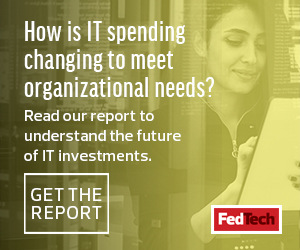Training and Data Analytics Are Seen as Key to Cybersecurity
Cybersecurity has always been a constant concern for federal IT leaders and its importance is even more evident now. With so many workers at home, agencies saw a large increase in phishing attacks, according to Federal CIO Suzette Kent.
According to CDW and IDG survey findings, 28 percent of federal respondents cite gaining visibility into and proactively mitigating risk as their top investment priority, just behind modernizing IT infrastructure (30 percent).
Further, 70 percent of federal survey respondents expect an increase in the percentage of their budgets that will be allocated to risk mitigation over the next two years.
How do IT leaders expect to enhance their cybersecurity posture? Exactly half of respondents cite increased security awareness and staff training, and 40 percent say that better use of data and analytics is a top risk mitigation objective.
DISCOVER: Learn how robotic process automation can hep your agency.
Mobility, Automation Can Enhance Workplace Productivity
Moving forward, there will likely be a mixture of users working from home and at agency offices. They will need technology tools to collaborate effectively and maintain productivity so that mission objectives can be achieved.
CDW and IDG survey findings reveal that the collaboration tools that have become more widely used in the past few months will continue to play a role in driving productivity, with 41 percent of respondents in the federal government sector planning to invest in collaboration over the next two years.
Automation is also seen as way to free up staff to focus on higher-value tasks. According to the survey, nearly half (49 percent) of federal respondents cite increasing automation as a top priority to improve workplace productivity.
Meanwhile, 44 percent of federal government respondents cite mobile solutions among their top planned IT investment to improve workplace productivity, flexibility and engagement. Thirty-four percent cite virtual meeting software as a key investment.
MORE FROM FEDTECH: Find out how your agency can leave legacy systems behind.
Cloud Is Essential to Federal IT Modernization
The federal government is more than a decade into using cloud-based technologies, but cloud’s importance has grown larger than ever. Cloud has allowed agencies to scale up telework solutions and other applications to a wide range of users operating outside of government networks.
Cloud is going to continue to be an integral area of investment moving forward, according to the CDW and IDG survey. Federal respondents expect Software as a Service to comprise 30 percent of their total IT infrastructure two years from now, and expect Infrastructure as a Service to make up 24 percent.
There are other tasks at hand besides simply embracing cloud when it comes to IT infrastructure modernization. According to the CDW and IDG survey, 46 percent of federal respondents say developing a long-term IT roadmap is their top priority over the next two years to modernize technology infrastructure and meet business objectives. Meanwhile, 36 percent say they will prioritize cloud monitoring and management.
READ MORE: Find out why you should include employees in the journey of deploying emerging tech.
Reimagining Processes Can Enhance the User Experience
Federal agencies are more aware than ever before of the importance of user experience, as many citizen-facing services go digital in response to the pandemic. Agency IT leaders have been working to enhance the user experience of their websites, applications and processes.
The CDW and IDG survey findings bear out that reality. According to the survey, 41 percent of federal respondents say redesigning processes to align with new technology is the top action they will take over the next two years to transform the customer experience, while 38 percent cite increasing process automation as the key action they will take.
According to the survey, 43 percent of federal respondents cite a changing regulatory/compliance environment as a top driver of investments to transform the customer experience. Almost half (49 percent) cite new global threats such as cybercrime, and growing need for data protection and privacy, as the key drivers.











